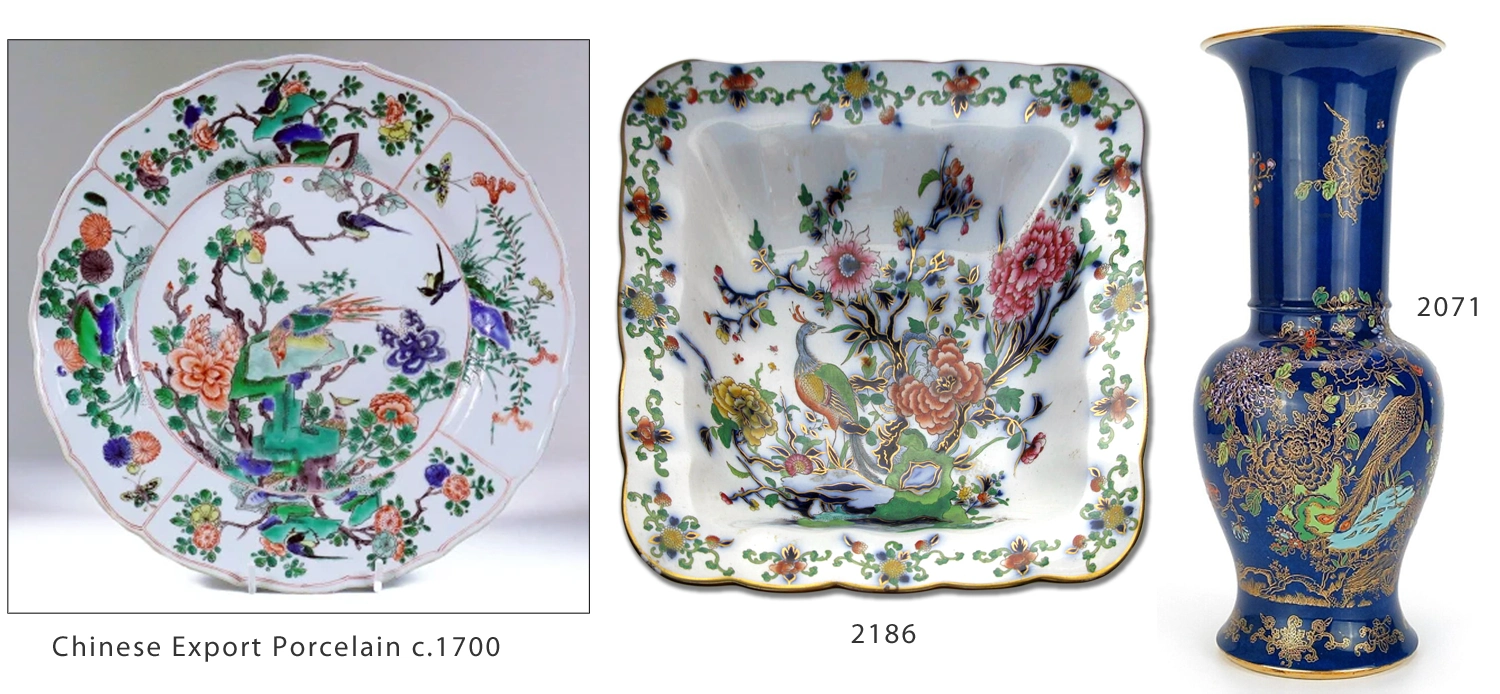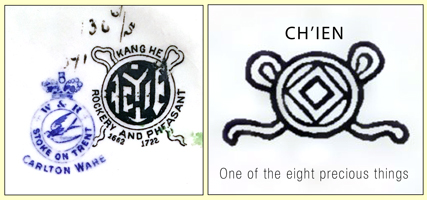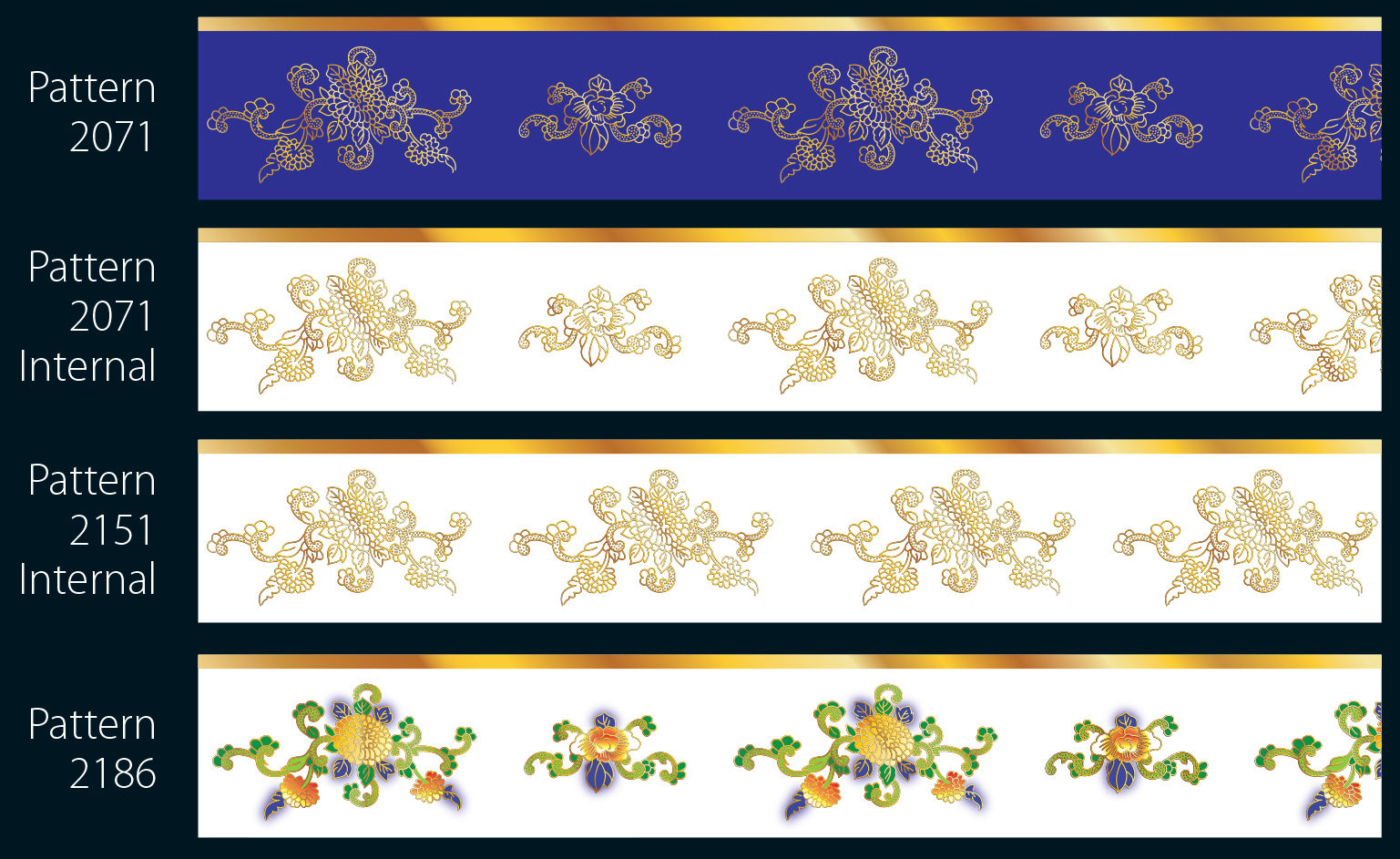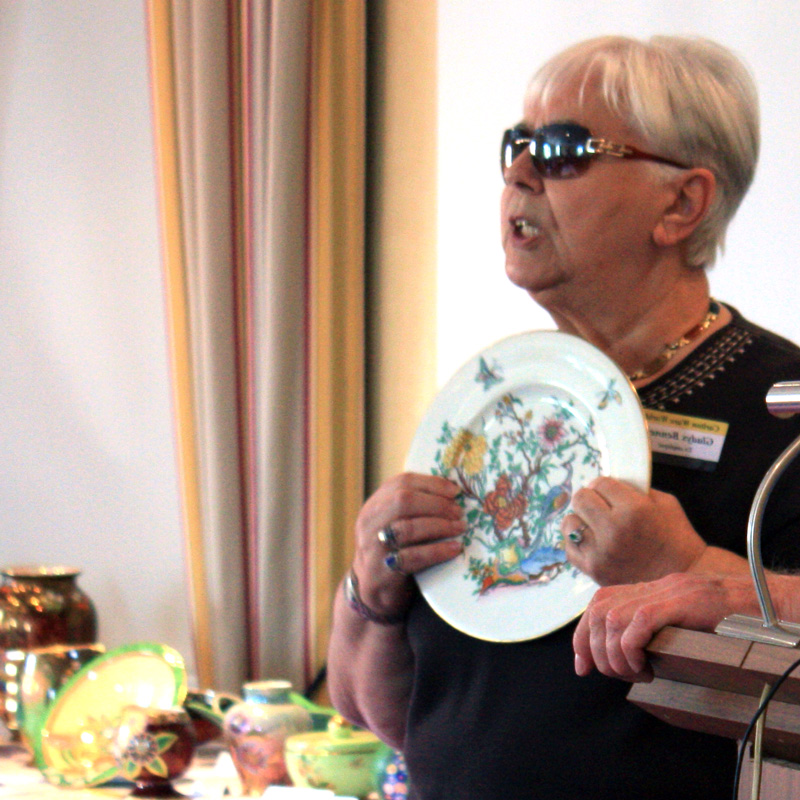
ROCKERY & PHEASANT
Carlton Ware's ROCKERY & PHEASANT pattern and its Border
by Harvey Pettitwith border artwork by Barbara Anne Lee
Scenes of exotic birds set among rocks, flowers and foliage often decorated seventeenth and eighteenth century Chinese export porcelains. Such compositions were frequently copied in the West and became a staple for many of the the Staffordshire potters. Carlton Ware's rendition of this pattern, devised by Horace Wain, was named ROCKERY & PHEASANT. Its date of introduction is close to the time when the twenty-six year old began his time at the Carlton Works around 1913, so was probably just before World War One or perhaps during it; giving an exact date is not possible.
On the left below is an example of a Chinese export porcelain plate from the Kang Hsi period (1622-1722), decorated in this widely replicated style of pattern still popular today with traditionalists. To the right of the Chinese plate are two examples of Carlton Ware's offerings. According to pattern records, eight variants were produced.

Right - Two examples of Horace Wain's ROCKERY & PHEASANT, his interpretation of this Chinese pattern for Carlton Ware.
2186 on the white ground appears to be printed in brown with parts of the pattern traced in flow blue and gold.
2071 is printed in gold agaist a POWDER BLUE ground.
To see the image above fit your device's screen and/or enlarge it click or tap it.
To return to this page use your back button
Notice that Carlton Ware's ROCKERY & PHEASANT has right and left hand versions so that matched pairs could be made. On one, the bird faces right, on the other, a different bird faces left. The rocks, foliage and flowers are also different for each hand.

Wain was fond of introducing special backstamps,
in this case probably cleverly suggesting that his pattern would make lots of 'coin' for his new employer! He could be playful with his design work.
The ROCKERY & PHEASANT Border
Below is the border mostly associated with Carlton Ware's ROCKERY & PHEASANT pattern that Barb has redrawn for us. It is unusual in that it is not continuous but made up of two elements, the larger one clearly based on chrysanthemum flowers.
 © Barbara Anne Lee 2023
© Barbara Anne Lee 2023 Below, Barb shows us how the border looks on different grounds.

To see the image above fit your device's screen and/or enlarge it click or tap it.
To return to this page use your back button
Occassionally, a sheet pattern, (so called because it was printed as a sheet rather than a border) was cut into strips and used as a border. This is another story! Like Topsy....
The ROCKERY & PHEASANT
Paintresses Practice Plates.
Like so many of Carlton Ware's patterns that were engraved onto flat copper plates for printing on to tissue paper to be transferred onto ware, ROCKERY & PHEASANT was highly detailed. A print of this elaborate pattern was applied to a dinner plate which was then used to train paintresses, who then had to add the coloured enamels to the pattern. The plate was only fired when perfectly decorated; it was then given to the paintress.
Until the trainee's brush work was up to Carlton Ware's high standards, the coloured enamels were wiped off and the trainee had to begin again and again until perfect. Below is Edna Rowlands' practice plate completed to the satisfaction of the "Missus", who was in charge of training, supervision and settling (working out paintresses wages).

To see the plate above fit your device's screen and/or enlarge it click or tap it.
To return to this page use your back button
The date of 1941 on Edna's plate is interesting in that it was painted during World War Two. Probably not long after finishing it, Edna may have been called up for the War effort to work in a munitions factory, as indeed was Dorothy Faulkner, who became the "Missus" after the war had ended. If Edna's painting had not been up to standard she would have been exterminated (just joking!). Clearly she passed with flying colours.

At a Carlton Ware World meeting in 2011, Gladys Bennett took to the floor to show us her practice plate and to speak about her time at the Carlton Works. Her recollections were a tour-de-force and a fine example of how proud the people of Stoke-on-Trent were of their work.
On the right is a picture of Gladys showing us her practice plate.
Sadly, Gladys passed away in 2019. You can read my tribute to her by clicking or tapping on her picture.
© Harvey Pettit March 2024
V3 - dates added October 2024
NOTE - To help you avoid mixing up pattern and shape names I use some simple typographic conventions. You can read them by clicking or tapping on the button on the left below.
Or